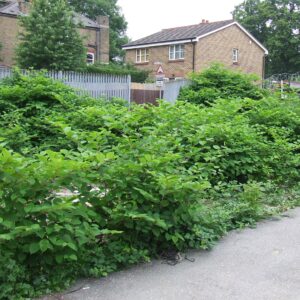‘Yes’, ‘No’ or ‘Not known’? Understanding the risks arising from the TA6 Japanese knotweed question
‘Yes’, ‘No’ or ‘Not known’? Environet’s article helps to understand the risks arising from the TA6 Japanese knotweed question.

The Law Society’s amendment to the Explanatory Notes accompanying the TA6 Property Information Form changed in 2020. In order for a seller to tick “No” to the Japanese knotweed question, they must “be certain that no rhizome (root) is present in the ground of the property, or within 3 metres of the boundary, even if there are no visible signs above ground.”
Clearly, if the seller is aware of its presence, their answer should be a definitive “Yes”. In this case, a professional survey should be commissioned, and a professional treatment plan put in place that is acceptable to the buyer, with an insurance-backed guarantee. If the buyer still wishes to proceed, it’s then up to the two parties to agree a price that fairly reflects the property’s value.
But for the vast majority who aren’t certain whether the property is knotweed-free, the question poses two notable problems for sellers and the property professionals advising them.
Rhizome hidden in the ground
Knotweed that has been herbicide treated in the past can be induced into a state of dormancy lasting several years. Often no above ground growth is visible, but the plant is technically alive and could start to regrow if the ground is disturbed through excavation or building work. As such, it’s practically impossible for a homeowner to state categorically that their home is not affected by knotweed.
Knotweed risk on adjacent land
A homeowner who is concerned about the presence of knotweed on an adjoining property can alert their neighbour to the risks, and once encroachment occurs, legal redress can be found in private nuisance which aims to compensate for detrimental impact on the use and enjoyment of the land. But until the knotweed encroaches across the boundary, the adjoining owner is under no obligation to act, making it difficult to force any action.
Rather unfairly, this leaves homeowners who wish to sell a property that is at risk of encroachment, relatively powerless. If the knotweed infestation is on adjoining property within 3 metres of the boundary, the seller should answer “Yes” on the TA6 form stating that their property is affected, making it harder to sell and negatively impacting its value.
Advising sellers who have responded “No” on the TA6
Proving a negative can be fraught with difficulty, but not so when knotweed emerges in the first spring after the sale. Hence, conveyancers acting for sellers who have responded “No” to the knotweed question on the TA6 form are advised to query how they can be so certain, especially bearing in mind the dormancy risks, and alert them to the potential legal implications if the information they have given is false. A safer response would be to tick “Not known” and provide accompanying evidence of a professional knotweed survey showing the property to be knotweed-free to the best of their knowledge.
Advising buyers who have received a “Not known” response
Where a seller has ticked “Not known”, the onus moves onto the buyer to carry out further investigations. It’s recommended that conveyancers advising buyers in this case should flag the risks and advise their client to carry out further checks by professionals before progressing.
How Just Check™ can help
JustCheck™ provides protection to both buyers and sellers by determining whether or not a property is affected by knotweed. Environet’s expert surveyors check the property for any sign or suspicion of knotweed, and where possible on adjoining land within 3 metres of the boundary. Assuming none is found or suspected a 5-year warranty is provided to cover the cost of up to £20,000 of treatment in the unlikely event the plant should later appear.
Case Study: Misrepresentation case costs seller £200,000
In January this year, a misrepresentation case relating to Japanese knotweed hit the headlines after a homebuyer in Raynes Park successfully sued the seller who had failed to declare that knotweed was present behind the shed in the garden.
The seller had answered ‘No’ to the knotweed question on the TA6 form and argued that he ‘reasonably believed’ he was telling the truth when he did so. The judge stated the seller’s case was undermined by his stating that he did not know what was behind the shed, and the fact that there was evidence the knotweed had been herbicide treated in the past. He was ordered to pay £32,000 damages plus £95,000 legal costs in addition to his own £100,000 legal bill.
It was the size of the bill that caught the eye of the media, the vast majority arising from legal costs – which is the reason why most knotweed misrepresentation cases are settled out of court for much smaller sums. For the cost of a JustCheckä survey at £325+VAT, this sorry saga could have been avoided. It’s also a welcome reminder that as a seller’s conveyancer, your client relies on you to tell them the TA6 is more than just a yes or no tick-box exercise, and for complete peace of mind, they should carry out thorough checks or commission a JustCheck™ survey before completing it.
Guidance from conveyancing professionals is vital to helping sellers understand the potential implications of answering “No” or “Not known” – and ensuring buyers understand how to mitigate the risks if they receive an ambiguous response.
Written by Nic Seal, founder of invasive plant specialists Environet.
Kindly shared by Environet



















